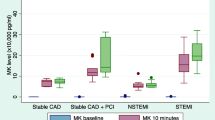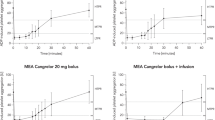Abstract
Antiischemic effectiveness of long-term urokinase therapy and isovolemic hemodilution therapy has been reported in patients with symptomatic coronary artery disease, but both interventions have never been compared. In patients with refractory angina pectoris and end-stage coronary artery disease (clinical functional class III), isovolemic hemodilution (n=9) (hydroxyethyl starch solution 6%, 1–2 times/week), and urokinase therapy (n=11) (500,000 U urokinase per i.v. injection, 3 times a week) were performed over a period of 12 weeks, each additionally to maximal conventional treatment. Apart from the assessment of clinical symptoms and rheologic parameters, invasive hemodynamic measurements were carried out at rest and during exercise testing before and after treatment. After treatment with urokinase, patients showed a significant reduction of clinical symptoms (from 19.8±6.5 to 5.0±4.3 anginal events/week,p<0.001), fibrinogen (from 410±88 to 238±40 mg/dl,p<0.001), plasma viscosity (from 1.45±0.10 to 1.33±0.03 mPa×s−1,p<0.01), and no changes of hematocrit (from 0.45±0.02 to 0.45±0.02) and whole blood viscosity (from 4.7±0.5 to 4.4±0.7 mPa × s−1); however, hemodilution resulted in a decrease of hematocrit (from 0.46±0.01 to 0.39±0.01,p<0.001) and whole blood viscosity (from 4.7±0.5 to 4.0±0.3 mPa×s−1,p<0.001) and no changes of initially comparable levels of clinical symptoms, fibrinogen, and plasma viscosity. Hemodynamic parameters at rest improved after urokinase therapy with a reduction of pulmonary capillary wedge pressure (from 9.1±5.1 to 5.5±2.8 mmHg,p<0.05) at comparable levels of systemic vascular resistance (from 1510±340 to 1420±510 dyn×s×cm−5). Hemodilution did not result in any significant hemodynamic changes. Apart from clinical symptoms, long-term intermittent urokinase therapy reduces pulmonary capillary wedge pressure at rest. This may reflect an improved diastolic function due to a rheological enhancement of myocardial perfusion at the level of the coronary microcirculation. Isovolemic hemodilution seems to be of no benefit.
Similar content being viewed by others
References
Schoebel FC, Frazier OH, Jessurun GAJ, et al. (1997) Refractory angina pectoris in end-stage coronary disease—evolving therapeutic concepts. Am Heart J 137:587–602.
Schoebel FC, Leschke M, Strauer BE (1995) Therapierefraktäre Angina pectoris. Pathophysiologische Grundlagen und alternative Therapieansätze bei der koronaren Herzkrankhteit. Dtsch Med Wochenschr 120:301–317.
Mekat A, Holdt B, Kittner C, et al. (1997) Klinische Erfahrungen mit der intermittierenden Urokinasetherapie in der Behandlung der inoperablen Koronarskelerose. Perfusion 10:390–396.
Leschke M, Schoebel FC, Mecklenbeck W, et al. (1996) Long-term intermittent urokinase therapy in patients with end-stage coronary-artery disease and refractory angina pectoris: A randomized dose-response trial. J Am Coll Cardiol 27:575–584.
Campeau L (1996) Grading of angina pectoris. Circulation 54:522–523.
Braunwald E (1989) Unstable angina—a classification. Circulation 80:410–414.
Swan HJC, Ganz W, Forrester J, et al. (1970) Catheterization of the heart in man with use of a flow-directed balloon-tipped catheter. N Engl J Med 283:447.
Buchwalsky R (1985) Einschwemmkatheter—Technik, Auswertung und praktische Konsequenzen. 2. überarbeitete Auflage. Erlangen: perimed Fachbuch-Verlagsgesellschaft, 103–170.
Leschke M, Blanke H, Stellwaag M, et al. (1988) Hyperfibrinogenämie und pathologische Plasmaviskosität. Dtsch Med Wochenschr 113:1175–1181.
Schoebel FC, Leschke M, Jax TW, et al. (1996) Chronic-intermittent urokinase therapy in patients with end-stage coronary artery disease and refractory angina pectoris—a pilot study. Clin Cardiol 19:115–120.
Schoebel FC, Jax TW, Fischer Y, et al. (1977) Antithrombotic treatment in stable coronary syndromes: Long-term intermittent urokinase therapy in end-stage coronary artery disease and refractory angina pectoris. Heart 77:13–17.
Chien S (1987) Physiological and pathophysiological significance of hemorheology. In: Clinical Hemorrheology, Cien S, Dormandy J, Ernst E, et al. (eds). Dordrecht: Martinus Nijhoff, 125–160.
Ehrly AM (1973) Verbesserungen der Fleisseigenschaften des Blutes: Ein neues Prinzip zur medikamentösen Therapie chronischer arterieller Durchblutungsstörungen. Vasa (suppl) 1:1–18.
Schannwell CM, Schoebel FC, Pölitz B, et al. (1997) Diastolic left ventricular function in patients with refractory angina pectoris after low-dose intermittent urokinase therapy. J. Am Coll Cardiol 29(suppl A):45 A.
Nesto RW, Kowalchuk GJ (1987) The ischemic cascade: Temporal sequence of hemodynamics, electrocardiographic and symptomatic expressions of ischemia. Am J Cardiol 27:23C-30C.
Kiesewetter H, Jung F, Erdlenbruch W, et al. (1992) Hemodilution in patients with peripheral arterial occlusive disease. Int Angiol 11:169–175.
Strad T (1992) Evaluation of long-term outcome and safety after hemodilution therapy in acute ischemic stroke. Stroke 23:657–662.
Wolf S, Arend O, Bertram B, et al. (1994) Hemodilution therapy in central retinal vein occlusion. One year results of a prospective randomized study. Graef Arch Clin Exp Ophthalmol 232:33–39.
Neubaur TER, Peters AJ, Schoebel FC, et al. (1996) Isovlämische Hämodilution bei koronarer Herzkranheit—klinische und hämodynamische Auswirkungen. Z Kardiol 85:1–5.
Leschke M, Schoebel FC, Strauer BE (1993) Anemia and the Heart. In: Bauer C, Koch KM, Scigalla P et al. (eds) Erythropoietin. Marcel Dekker, New York, Basel, Hong Kong; pp 93–105.
Fowler NO, Holmes JC (1969) Blood viscosity and cardiac output in acute experimental anemia. J Appl Physiol 39:453–456.
Ehrly AM (1973) Verbesserung der Fließeigenschaften des Blutes: ein neues Prinzip zur Therapie chronischer peripherer arterieller Durchblutungsstörungen. Vasa 2(suppl 2):2–27.
Gordon RJ, Kavin MB, Dalcoff GR (1979) Blood Rheology. In: Thomas CC, (ed) Cardiovascular Physiology for Anethesiologists. Thomas, Springfield, il; pp 27–71.
Most S, Ruocco NA, Gerwitz H (1986) Effect of a reduction in blood viscosity on maximal myocardial oxygen delivery distal to a moderate coronary stenosis. Circulation 74:1085–1092.
Spahn DR, Leone BJ, Reves JG, et al. (1993) Cardiovascular and coronary physiology of acute isovolemic hemodilution: a review of nonoxygen-carrying and oxygen-carrying solutions. Anaesth Analg 78:1000–1021.
Author information
Authors and Affiliations
About this article
Cite this article
Peters, A.J., Schoebel, FC., Jax, T.W. et al. Long-term urokinase therapy and isovolemic hemodilution: A clinical and hemodynamic comparison in patients with refractory angina pectoris. International Journal of Angiology 8, 44–49 (1999). https://doi.org/10.1007/BF01616843
Issue Date:
DOI: https://doi.org/10.1007/BF01616843




